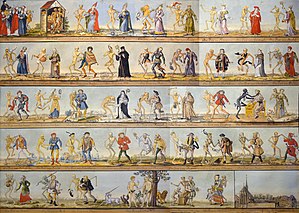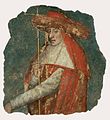Basel dance of death

|
| Watercolor copy of the Basel Dance of Death from 1806 (Johann Rudolf Feyerabend) |
|---|
| Original from the 15th century with later revisions |
| Original: tempera paints on plaster |
| 200 × 6000 cm |
The Basler Totentanz , as death from Basel known, refers to a picture that in the late Middle Ages in Basel on the inside of the cemetery wall in Predigerkirche was painted and the Totentanz showed. The painting is a memento mori , i. That is, it is a warning reminder that death tears everyone from life, regardless of their status.
Emergence
The painting was on the inside of a sixty meter long and two meter high cemetery wall of the lay cemetery of the preacher's monastery and was painted on the plaster with tempera paints . The cemetery belonged to the Dominicans . The fresco came from the 15th century (probably 1440 by Konrad Witz or his painting school), its precise history or who commissioned it could not be determined.
The Basler Totentanz contained a sermon picture at the beginning and the fall of man and the depiction of the Last Judgment at the end . This gave this portrayal a biblical dimension.
An older representation of the dance of death was in the Klingental monastery on the Kleinbasel side of the Rhine , but this work has also not survived. However, Emanuel Büchel made copies between 1766 and 1768 and recognized a close relationship between these two pictures. The Klingental dance of death only showed the actual dance.
First restoration
The Basler Totentanz survived the Basel iconoclasm of 1529. In 1568, the Basel council commissioned the painter Hans Hug Kluber to renovate the painting in line with the contemporary taste. The original style of the dance of death was also changed in terms of content: the preacher received the facial features of the Basel reformer Johannes Oekolampad , the figures were dressed according to the fashion of the time, the skeletons were painted more anatomically and in the end the painter Kluber joined himself and his family with two skeletons added.
Second restoration
From 1614 to 1616 Emanuel Bock , one of the sons of the painter Hans Bock the Elder , restored the dance of death again, but did not change the picture as much. Only the fleshy, bulging faces seem to be from his hand.
Matthäus Merian d. Ä.
Immediately after this restoration, Matthäus Merian d. Ä. performed the dance of death and transferred it along with the rhymes to copper plates . He had set himself the task of breaking up the scenes of the monumental dance of death on the Basel cemetery wall running from right to left into individual scenes and publishing them in book form using the means of printmaking.
In 1621 Johann Jakob Merian published the engravings in book form for the first time; two more editions by Matthäus Mieg followed in 1621 and 1625. But only the revision of the copper plates by Matthäus Merian d. Ä. and its 4th edition (Frankfurt am Main 1649), published by his father-in-law's publishing house Johann Theodor de Bry , made painting known throughout Europe and also found its way into travelogues. After Merian's death, new editions often followed. a. 1696 and 1698 with the original plates, 1744, 1756, 1786 and 1789 with copy etchings and in 1830 by the von Mechel brothers. In the Kunstmuseum Basel Merian plates of the new edition can be seen from the 1744th
Based on the motifs from the 1625 edition or a later reprint of this work, the Baden artist Anton Sohn (1769–1840) made terracotta images of the dance of death in 1822 . These Zizenhausen terracottas can be viewed , for example, in the Konstanz Rosgarten Museum , the Stockach Stork Tower Museum or the Kassel Museum for Sepulchral Culture .
Third and fourth restoration
From 1657 to 1658 and 1703 the picture was restored again, but in the 18th century an indifference to the picture and the whole cemetery began.
Copy and abort
From 1770 to 1773 the topographer Emanuel Büchel made a copy of the dance and the verses on behalf of the Basel building authority using pen, brush and water color. He tied these copies in an album, in which a dancing couple with the corresponding verse is depicted on each page.
The wall and the picture became more and more neglected and on August 5th and 6th, 1805 the "eyesore" was broken off and the picture destroyed. Art lovers in Basel saved 23 image and 3 text fragments. Over time, 19 of them came back into public ownership. These are exhibited today in the Basel Historical Museum .
- Wall paintings in the Basel Historical Museum
Today the former cemetery area is assigned to the green zone and a public park. It is flanked by 33 trees and to the northeast by a row of houses on the Rhine side, northwest by the “Bockstecherhof” and south by the Predigerkirche. For a long time the tram station there was called “Totentanz” before it was renamed “Predigerkirche” and later “University Hospital” out of consideration for the adjoining hospital .
The Austrian painter and art teacher Herwig Zens (1943–2019) created the “Basler Totentanz” project in 1990.
literature
- Matthäus Merian : Todten-Tanz, like the same in the löbl. and world-famous city of Basel is artificially ground and can be seen as a mirror of human nature: brought to the original in copper along with a description of the city of Basel. Im-Hof, Basel 1744 (published 1789) digitized
- Matthaeus Merian: Todten-Tantz, like the same in the praiseworthy and well-known instead of Basel, as a mirror of human nature, wholly artificially ground, can be seen with attached memories drawn from H. Schrifft and the old church teachers, of death, resurrection, youngest Judgment, condemnation of the wicked, and eternal life. Frankfurt a. M. 1649 ( digitized copy from the Danish Royal Library )
- Matthaeus Merian the Elder: Todten-Tantz, like the same in the laudable and far-famous city of Basel As a mirror of human nature, wholly artificially ground and seen: With attached memories of Todt drawn from H. Schrifft and those of old church teachers , Resurrection, last judgment, damnation of the wicked and eternal life. Andreä & Hort, Frankfurt 1725. ( digitized edition )
-
The Basel death dances: in addition to a historical investigation, as well as a comparison with the other German death dances, their sequence of images and their common rhyming texts. Scheible, Stuttgart 1847 ( digitized edition )
- The Basel dance of death. Stuttgart 1847 ( digitized edition of the University and State Library Düsseldorf ). Illustrated atlas as a new edition of Merian's illustrated book.
- Death dance of the city of Basel: Engraved in copper after the fresco paintings on the former churchyard wall of the Predigerkirche. Fuchs, Basel approx. 1830 ( digitized edition of the University and State Library Düsseldorf)
- Death dance of the city of Basel: Engraved in copper after the fresco paintings on the former churchyard wall of the Predigerkirche. Fuchs, Basel (approx. 1830) digitized
- Theophil Burckhardt-Biedermann : Basel dances of death. In: Contributions to patriotic history. New series, Volume 1, Basel 1882.
- Theophil Burckhardt-Biedermann: Again the Basler Death Dances. In: Basler Zeitschrift für Geschichte und Altertumskunde , Vol. 10, 1911, pp. 197-258. ( Digitized version )
- Rolf Paul Dreier: The Dance of Death - a motif of church art as a projection surface for profane messages (1425–1650). Leiden 2010, ISBN 978-90-90251-11-0 (including CD-Rom: Directory of the Dances of Death, also on www.totentanz.nl). Especially on the dance of death in Basel: pp. 46–78, 133–178.
- Death dance of the city of Basel: Engraved in copper after the fresco paintings on the former churchyard wall of the Predigerkirche. (Preferred edition) Fuchs, Basel approx. 1830. ( Digitized edition )
- Death dance of the city of Basel. Beck, Basel 1875. ( digitized edition )
- Georg Scharffenberg: The Todten-Tantz, like the same one in the broad-rumored Statt Basel, as a mirror of human nature, artificially ground with lively colors, not without useful astonishment: Original woodcuts from the sixteenth century; with the German verse. Danz, Leipzig 1870. ( digitized edition )
- Franz Egger : Basel Dance of Death. 2., ext. Edition Basel 2009.
- Helmut Andreas Grieshaber : Dance of Death from Basel. Dresden 1966.
- Hans Georg Wehrens: The dance of death in the Alemannic language area. "I have to do it - and don't know what". Schnell & Steiner, Regensburg 2012, ISBN 978-3-7954-2563-0 , p. 50ff. and 72ff.
Web links
Individual evidence
- ↑ Friedrich v. Zglinicki : Uroscopy in the fine arts. An art and medical historical study of the urine examination. Ernst Giebeler, Darmstadt 1982, ISBN 3-921956-24-2 , p. 83.
- ↑ Hans Georg Wehrens: The dance of death in the Alemannic language area. "I have to do it - and don't know what". Schnell & Steiner, Regensburg 2012, ISBN 978-3-7954-2563-0 . P. 199ff.
- ^ Friedrich von Zglinicki: The Uroscopy in the fine arts. An art and medical historical study of the urine examination. GIT Verlag Ernst Giebler, Darmstadt 1982, ISBN 3-921956-24-2 , p. 83 f.
- ↑ Wilfried Seipel: The world view of the Zizenhausen figures. Book accompanying the exhibition of the same name. Verlag Friedr. Stadler, Konstanz 1984, ISBN 3-7977-0084-9 .
- ^ Storchenturm-museum.de: Tour of the museum: Basler Totentanz , accessed on August 13, 2012



















